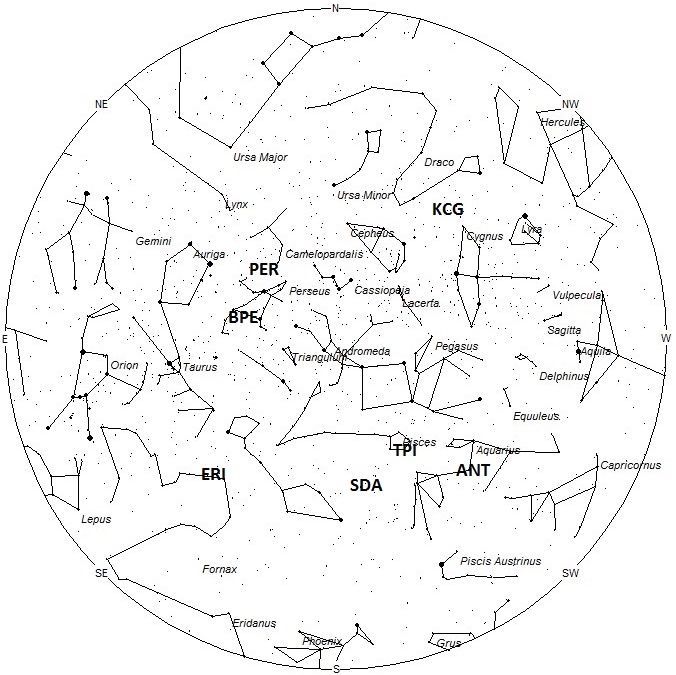
Perseids 2011 (composite photo) – Omu Peak, Romania © Alex Tudorica
During this period the moon reaches its new phase on Friday August 14th. At this time the moon is located near the sun and is invisible at night. This weekend the waning crescent moon will rise during the early morning hours but will not interfere too much with meteor viewing. While not nearly as bright as a full moon, the crescent moon can be annoying. The key is to keep the moon out of your field of view while observing. The estimated total hourly meteor rates for evening observers this week is near 5 as seen from mid-northern latitudes (45N) and 4 as seen from tropical southern locations (25S). For morning observers the estimated total hourly rates should be near 30 as seen from mid-northern latitudes (45N) and 20 as seen from tropical southern locations (25S). The actual rates will also depend on factors such as personal light and motion perception, local weather conditions, alertness and experience in watching meteor activity. Note that the hourly rates listed below are estimates as viewed from dark sky sites away from urban light sources. Observers viewing from urban areas will see less activity as only the brightest meteors will be visible from such locations.
The radiant (the area of the sky where meteors appear to shoot from) positions and rates listed below are exact for Saturday night/Sunday morning August 8/9 These positions do not change greatly day to day so the listed coordinates may be used during this entire period. Most star atlases (available at science stores and planetariums) will provide maps with grid lines of the celestial coordinates so that you may find out exactly where these positions are located in the sky. A planisphere or computer planetarium program is also useful in showing the sky at any time of night on any date of the year. Activity from each radiant is best seen when it is positioned highest in the sky, either due north or south along the meridian, depending on your latitude. It must be remembered that meteor activity is rarely seen at the radiant position. Rather they shoot outwards from the radiant so it is best to center your field of view so that the radiant lies at the edge and not the center. Viewing there will allow you to easily trace the path of each meteor back to the radiant (if it is a shower member) or in another direction if it is a sporadic. Meteor activity is not seen from radiants that are located below the horizon. The positions below are listed in a west to east manner in order of right ascension (celestial longitude). The positions listed first are located further west therefore are accessible earlier in the night while those listed further down the list rise later in the night.
These sources of meteoric activity are expected to be active this week.
Even with over 3,000 members of the Kappa Cygnids (KCG) present in the IMO video database, this source is difficult to pinpoint. It seems that early Kappa Cygnids are active from 2 radiants. A southern radiant is currently located at 18:28 (277) +48. This area of the sky is located on the Draco/Lyra border, 9 degrees north of the brilliant 0 magnitude star known as Vega (Alpha Lyrae). This southern source peaks on August 10th with low rates. The southern source ends on August 15th and the better known northern source takes over and peaks on August 18th. The northern source (aka August Draconids) is currently located at 17:24 (261) +63. This area of the sky lies in Draco, just a few degrees southeast of the 3rd magnitude star known as Al dhibain (Zeta Draconis). These meteors are best seen as soon as it becomes dark in the evening hours. Rates are expected to be less than 1 no matter your location. With an entry velocity of 19 km/sec., the average Kappa Cygnid meteor would be of slow velocity.
The last of the Alpha Capricornids (CAP) will occur this week. The radiant is located at 20:48 (312) -07. This position lies in western Aquarius, just south of the faint star known as 3 Aquarii. The radiant is best placed near 0100 local daylight time (LDT) when it lies on the meridian and is highest in the sky. Rates are expected to be less than 1 no matter your location. With an entry velocity of 22 km/sec., the average Alpha Capricornid meteor would be of slow velocity.
The center of the large Anthelion (ANT) radiant is currently located at 21:56 (329) -10. This position lies in northeastern Capricornus, 5 degrees southeast of the 3rd magnitude star known as Sadalsuud (Beta Aquarii). These meteors may be seen all night long but the radiant is best placed near 0200 LDT when it lies on the meridian and is positioned highest in the sky. Due to the large radiant area, meteors from this source may also appear to radiant from the constellation of southeastern Aquila, western Aquarius as well as Capricornus. Rates at this time should be near less than 2 per hour as seen from the northern hemisphere and 3 per hour as seen from south of the equator. With an entry velocity of 30 km/sec., the average Anthelion meteor would be of slow velocity.
The Theta Piscids (TPI) are active from August 8 through September 1, with the peak falling on August 20th. These meteors have a radiant located at 22:48 (342) +01. This area of the sky is located on the Pisces/Aquarius border, 3 degrees east of the 4th magnitude star known as Eta Aquarii. The radiant is best placed near 0300 LDT, when it lies highest in the sky. Rates are expected to be near 1 per hour no matter your location. With an entry velocity of 39 km/sec., most activity from this radiant would be of average velocities.
The Delta Aquariids (SDA) are still active from a radiant located at 23:20 (350) -13. This position is located in southeastern Aquarius, 5 degrees northeast of the third magnitude star known as Skat (Delta Aquarii). Hourly rates will range from 1 per hour as seen from mid-northern latitudes to 3 per hour visible in southern tropical latitudes. The radiant rises near 2200 (10pm) LDT for observers located in the mid northern latitudes, but is best placed near 0300 LDT, when it lies highest in the sky. With an entry velocity of 42 km/sec., most activity from this radiant would be of average velocities.
The last of the Piscids Austrinids (PAU) will be seen this week. The radiant is located at 23:28 (352) -28. This position lies in northwestern Sculptor, 6 degrees northeast of the bright first magnitude star Fomalhaut (Alpha Piscis Austrinus). The radiant is best placed near 0300 LDT, when it lies highest in the sky. Rates are expected to be less than 1 per hour no matter your location. With an entry velocity of 35km/sec., most activity from this radiant would be of average velocities.
The Perseids (PER) will reach maximum activity on Thursday morning August 13th. See the Perseid article on the AMS website on how to best view this display. This weekend the radiant will be located at 02:48 (042) +57. This area of the sky lies in northern Perseus, just north of the 4th magnitude star known as Miram (Eta Persei). This area of the sky is best seen during the last hour before dawn when the radiant lies highest above the horizon in a dark sky. Rates (at 4am local daylight saving time) are expected to be near 10 per hour as seen from the northern hemisphere and 2 per hour as seen from south of the equator. Rates seen earlier in the night will be less. With an entry velocity of 61 km/sec., the average Perseid meteor would be of swift speed.
The Eta Eridanids (ERI) are active from a radiant located at 02:52 (043) -11. This area of the sky is located in western Eridanus 2 degrees southwest of the 4th magnitude star known as Azha (Eta Eridani). This area of the sky is best seen during the last hour before dawn when the radiant lies highest above the horizon in a dark sky. Rates are expected to be near 1 per hour no matter your location when the radiant is favorably placed in the sky. With an entry velocity of 66km/sec., most activity from this radiant would be of fast velocities.
The Beta Perseids (BPE) are active from July 27 through August 20th with maximum activity occurring on August 7th. The radiant is currently located at 03:08 (047) +37. This position lies in southwestern Perseus, 4 degrees south of the famous eclipsing variable star known as Algol (Beta Persei). Current rates are expected to be near 2 per hour as seen from the northern hemisphere and less than 1 as seen from south of the equator. The radiant is best placed during the last hour before the start of morning twilight when it lies highest in a dark sky. With an entry velocity of 68 km/sec., most activity from this radiant would be swift. This source was previously listed as the Alpha Triangulids (ATR)
As seen from the mid-northern hemisphere (45N) one would expect to see approximately 12 sporadic meteors per hour during the last hour before dawn as seen from rural observing sites. Evening rates would be near 4 per hour. As seen from the tropical southern latitudes (25S), morning rates would be near 9 per hour as seen from rural observing sites and 3 per hour during the evening hours. Locations between these two extremes would see activity between the listed figures.
The table below presents a list of radiants that are expected to be active this week. Rates and positions are exact for Saturday night/Sunday morning except where noted in the shower descriptions.
| SHOWER | DATE OF MAXIMUM ACTIVITY | CELESTIAL POSITION | ENTRY VELOCITY | CULMINATION | HOURLY RATE | CLASS |
| RA (RA in Deg.) DEC | Km/Sec | Local Daylight Time | North-South | |||
| August Draconids (AUD) | Aug 13 | 17:24 (261) +63 | 20 | 22:00 | <1 – <1 | IV |
| Kappa Cygnids (KCG) | Aug 10 (Southern Branch) | 18:28 (277) +48 | 19 | 23:00 | <1 – <1 | II |
| Alpha Capricornids (CAP) | Jul 27 | 20:48 (312) -07 | 22 | 01:00 | <1 – <1 | II |
| Anthelions (ANT) | – | 21:56 (329) -10 | 29 | 02:00 | 2 – 3 | II |
| Theta Piscids (TPI) | Aug 20 | 22:48 (342) +01 | 39 | 03:00 | 1 – 1 | IV |
| Delta Aquariids (SDA) | Jul 29 | 23:20 (350) -13 | 42 | 03:00 | 1 – 3 | I |
| Piscids Austrinids (PAU) | Jul 28 | 23:28 (352) -28 | 35 | 03:00 | <1 – <1 | II |
| Perseids (PER) | Aug 13 | 02:48 (042) +57 | 61 | 06:00 | 10 – 2 | I |
| Eta Eridanids (ERI) | Aug 20 | 02:52 (043) -11 | 66 | 06:00 | 1 – 1 | IV |
| Beta Perseids (BPE) | Aug 07 | 03:08 (047) +37 | 61 | 06:00 | 2 – <1 | IV |
 American Meteor Society
American Meteor Society



How can I communicate with other members and share info? Thank you
John and All,
Using this forum is a start. You may also consider joining “meteorobs” where serious observers share their data and experiences. To join meteorobs visit the following website: http://lists.meteorobs.org/mailman/listinfo/meteorobs
Robert Lunsford
What time will the meteor showers be visible in Netherlands
The Perseids are visible all night long from the Netherlands, as they are from most other locations in the northern hemisphere. They are best seen during the morning hours when the radiant (the area of the sky the meteors seem to come from) lies much higher in the sky.
Robert Lunsford